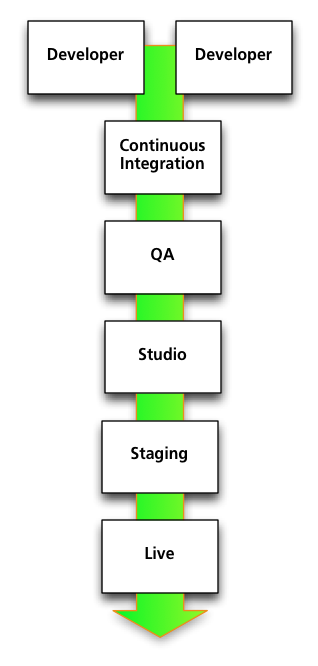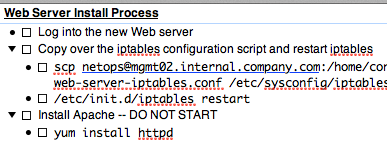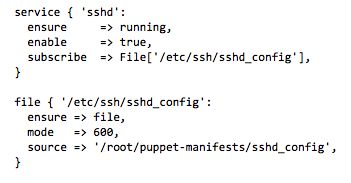Devops was a concept on the horizon two years ago. Since then I’ve had the chance to dig into it, figure out what I didn’t understand then, and implement an agile devops focused work environment. In the interests of demystifying what I do, I’m going to lay out what all those buzzwords currently mean to me. Spoiler: I still don’t think continuous deployment all the way to live makes sense for MMOs. Social games may be another matter.
First Principle
Devops is the principle of applying software development methodologies to the discipline of system administration and vice versa. There are couple of reasons to do this. First, the two fields are closely related and they have a lot to learn from one another. At the end of the day you’re giving directions to computers and hoping you said it right. If developers have learned some cool tricks for double-checking your hopes before you subject them to a live datacenter, bonus. If system administrators have learned some stuff about testing code in the same live datacenter and we can pull those tests forward in the dev process, double bonus.
Second, there’s a tendency for groups using the same techniques to talk more. Anything that gets groups to talk more is a good thing. I have a grand plan to invent marketops sometime in the next couple of years just so I can get marketing and operations groups to talk more. Mardevops comes next. Don’t think I’m not serious.
OK, so we have a principle and some reasons why it’s a good idea. Let’s break that down a bit further and spend a little time on the techniques we can use to realize that principle.
Configuration is Code
The buzzphrase is “infrastructure is code.” This is a lie and I actually think it’s a bit damaging. Over the last five years, virtualization has made it very easy to think of computers as non-physical objects that can be completely reconfigured remotely. Modern server hardware technology helps; if your servers are blades, the blade chassis containing them probably manages a lot of the individual blade configuration, and any blade you plug into a given slot in the chassis will behave according to how you’ve configured that slot.
However, you’re still dealing with cables and heat profiles and power requirements. Infrastructure involves the physical. Even if we’re using a cloud, it’s critical to think about the underlying hardware in order to better understand how to provide redundancy and resilience. Consider the April 2011 Amazon EC2 outage.
Configuration is code, though. It’s just instructions for computers. Therefore, it benefits from being treated like code.
The easy implication is that we should be storing our configuration files in source control. Everyone sane does that already, so that was pretty easy. We should also be acting like we’re coders. This is harder. But do it: use code review on every configuration checkin, even if it’s just someone else eyeballing it.
Taking a step back, configuration should undergo the same kind of promotion process you’d expect from any development team. You want to be performing continuous builds. For operations, this means that every time someone modifies a configuration file, that file gets pushed into a test environment and an automated process makes sure that the device being configured still runs.
Scrum, Sometimes
Every game company I’ve worked for has used some form of Scrum methodology for development. Online game operations groups should get on the bandwagon. Carefully.
If you try to apply Scrum to everything you’ll do in operations, you’ll find out pretty quickly that Scrum is designed for projects and you do a lot of maintenance work. Don’t try and use Scrum there. If something breaks, do not write a user story about how “As a user, I would like gameserver01.bos.gamecompany.com to be functional.”
Instead, treat it as a bug. Use your existing bug system if possible. This is convenient because it’s pretty easy to explain priority A bugs to your producers, and they’ll understand why it’s affecting your velocity. This also subtly implies that QA should be involved in verifying the fixes. That’s not an accident.
Also, identify tasks that can’t be decomposed into sprint-sized chunks and think about applying Kanban techniques there. Clinton Keith threw out Kanban as the appropriate agile operations technique in a seminar I took once. It’s not the be all and end all — that’s a misapprehension caused by not enough communication between development and operations — but it’s not bad if you’re doing a lot of repetitive tasks.
Finally, cross-fertilize your scrums. I don’t think we really want an operations scrum; rather, we want a datacenter scrum, which is primarily focused on operational tasks. We want a security scrum, which needs both operational security guys and developers. We want operations people sitting on most if not all engineering-oriented scrums. Scrum is a great fit for devops because it’s oriented towards projects, not functional groups.
Testing
You don’t want developers writing code without QA involved. The same applies to system administrators.
Load testing, security monitoring, and functionality monitoring are part of good data center infrastructure. They should be part of the development and build process as well.
Squish those two together and you wind up wanting to do full stack testing as early on as possible. Testing in a simulation of a live environment — here’s where cloud technologies come in — is really useful. This makes QA involvement a natural part of the process; you want to bring the traditional code branch into an integration environment with the ops configuration branch as soon as possible. The idea is to find out if your wacky configuration ideas break the carefully crafted software earlier rather than later.
Since you’re filing infrastructure issues as bugs, you already need QA to understand how to find and report bugs in your stuff, so that all works out rather well.
Next Up
I want to dig further into each of those techniques, and I also want to talk a bit about how you can get from zero to devops. I’ll probably do the latter next. Thanks for reading, particularly since it’s been a long long while.
 Here’s a generic simplified code promotion path. There are a bunch of developers coding away on their workstations or individual development servers. They check their changes into source control. Every time a change is checked in, the server gets rebuilt and a series of automated tests get run. If the build compiles successfully and passes the tests, it’s automatically pushed to the Continuous Integration environment.
Here’s a generic simplified code promotion path. There are a bunch of developers coding away on their workstations or individual development servers. They check their changes into source control. Every time a change is checked in, the server gets rebuilt and a series of automated tests get run. If the build compiles successfully and passes the tests, it’s automatically pushed to the Continuous Integration environment.
